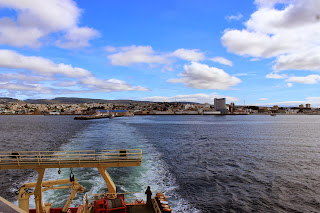We left Punta Arenas on Thursday, February 13 around mid-day. We were
saying goodbye to this continent for 5 weeks and looking forward to
seeing our next…Antarctica. We traveled for about 12 hours through
the Straits of Magellan. Ian and Dave spotted some interesting dolphin
with coloring very similar to an Orca. Can anyone name it? Leave a
comment…see who is first.
We have stayed busy getting as much prepared for our science days as we
can and running through a couple safety drills. Although we would love
to set up our labs for sampling, most of our gear and the remainder of
our crew are actually already at Palmer Station (see previous posts), so
there isn't much we can do. Once we arrive at Palmer, we will quickly
transfer all of our sampling gear onto the ship. However, we did
prepare a clean room…the "bubble"…for sampling ocean waters for
iron (Fe). Iron is found at very low concentrations in the ocean, so
sampling must be done with extreme care to prevent contamination from
the ship, sampling gear, or even particles in the air. So, the bubble
is used as a clean space. It is essentially a space, including lab
bench, which is completely encased in plastic. The air that is blown
into the bubble first passes through a very fine filter to remove all
particles. So, the bubble is under positive pressure, preventing any
ambient air from entering the space and keeping the area clean.
The weather was very calm, even after coming out of the Straits.
However, that quickly changed as we rounded Cape Horn. The wind built
to about 50 knots (~60 mph) and the waves rose to 20-25 feet. We have
been rocking and rolling for about 18 hours now. In fact, the LMG had
to steer into the waves (toward the West) for several hours during the
middle of the night, altering our course, rather then take the waves
broadside. We have been told that the waves should subside in the next
24 hours. Time will tell…
Although the LMG is 230 feet long and built for seas found in the
Southern Ocean, it still is not easy to do much when the waves are at
such a state. It is often difficult to simply stay in your bunk, let
alone walk through the narrow halls and stairwells. As you often hear,
one hand for the boat and one for yourself. This is certainly true
during rough conditions…you always want to be holding on to something,
preparing for the next RRROOOOLLLLLLL. That said, everyone seems to be
managing quite well and not one of us has succumbed to motion
sickness…YET!






I finally figured out the dolphin! I completely admit to having to do research to figure it out though. It's Commerson's Dolphin, or Cephalorhynchus commersonii.
ReplyDelete